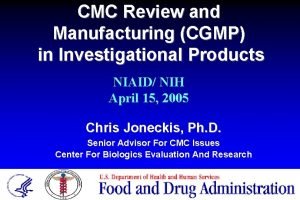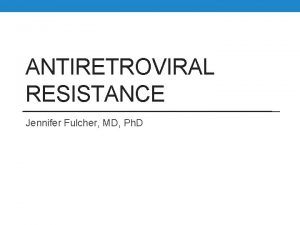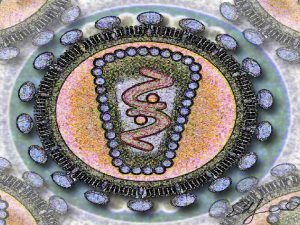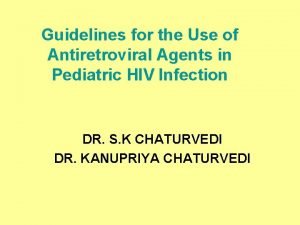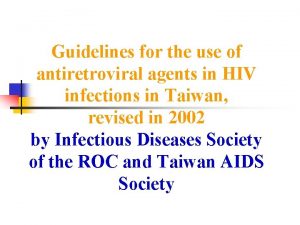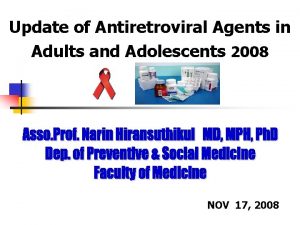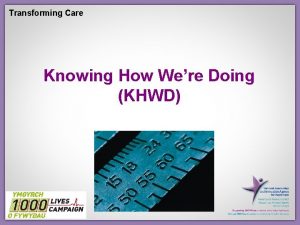Investigational Antiretroviral Agents Transforming the Care of People
































- Slides: 32

Investigational Antiretroviral Agents: Transforming the Care of People with HIV

Financial Relationships With Commercial Entities Dr Gandhi has served on the scientific advisory board for Merck & Co, Inc. (Updated 04/06/21) Slide 2 of 33

Learning Objectives Upon completion of this webinar, learners will be able to: • Summarize how new antiretroviral medications may be used in the future • Describe examples of new agents that are being developed to treat HIV Slide 3 of 33

What is the Future of ART? Why we need new ART New Drugs How we will use new drugs But we’re going to try! Slide 4 of 33

Why we need new ART • >30 drugs for treating people with HIV: high rates of viral suppression, low rates of toxicity • Current regimens have limitations: • Weight gain, drug interactions • Daily oral dosing: challenge for some of the most vulnerable people • Limited information on safety during pregnancy • High costs, especially in US Why we need new ART New drugs How will use new drugs? Slide 5 of 33

Why we need new ART: Examples People doing Well on ART 25 yo F. Virologically suppressed on single pill combination. Wants to take fewer medicines: worried about what they will do to her “over the long term” People Struggling with Daily Oral ART 45 yo M. Swallowing difficulties, depression. On-again, off-again virologic suppression. People with Multi-drug Resistant HIV Why we need new ART New drugs 55 yo M with HIV since 1990 s. Has been on multiple regimens. Now has virus resistant to all available classes. How will use new drugs? Slide 6 of 33

Desiderata: “Things Wanted or Needed” Need People doing Well on ART People Struggling with Daily Oral ART People with Multidrug Resistant HIV Fewer drugs ✓ ✓ -- Less toxicity ✓ ✓ ✓ Reduced Dosing Frequency ✓ ✓✓✓ -- High Barrier to Resistance ✓ ✓✓✓ -- Active against drug resistant HIV -- -- ✓✓✓ Less Visibility/Reduced Stigma ✓ ✓✓✓ ✓ Safety During Pregnancy ✓ ✓ ✓ Lower Cost/Better Access ✓ ✓ ✓ Why we need new ART New drugs How will use new drugs? Slide 7 of 33

Major Classes of Antiretroviral Medications Entry inhibitors: Attachment inhibitor: Fostemsavir UB-421 CCR 5 Antagonist: Leronlimab Fusion Inh. : Albuvirtide Multisite: Combinectin Broadly neutralizing Abs Maturation inhibitor GSK 3640254 (nonboosted) Capsid inhibitor Lenacapavir Reverse Transcriptase Inh. (RTI) Nucleoside RTI (NRTIs) Nonnucleoside RTI (NNRTIs) Long-acting rilpivirine (RPV) MK-8507 Nucleoside RT translocation inhibitor: Islatravir Protease inhibitors Integrase strand transfer inhibitors (INSTI) Long-acting cabotegravir (CAB) Gandhi M, Gandhi RT. NEJM 2014; 371: 248 -259.

New Drugs in Development Entry inhibitors: Attachment inhibitor: Fostemsavir UB-421 CCR 5 Antagonist: Leronlimab Fusion Inh. : Albuvirtide Multisite: Combinectin Broadly neutralizing Abs Maturation inhibitor GSK 3640254 (nonboosted) Capsid inhibitor Lenacapavir Reverse Transcriptase Inh. (RTI) Nucleoside RTI (NRTIs) Nonnucleoside RTI (NNRTIs)) MK-8507 Nucleoside RT translocation inhibitor: Islatravir Protease inhibitors Integrase strand transfer inhibitors (INSTI) Long-acting cabotegravir (CAB) Gandhi M, Gandhi RT. NEJM 2014; 371: 248 -259.

NRTTI Islatravir (MK-8591) • Nucleoside RT translocation inhibitor (NRTTI) • Potent at low doses: single oral dose as low as 0. 5 mg suppressed HIV RNA for >7 days • High barrier to resistance • Long intracellular half-life (78 -120 h) • Potential for once daily, once weekly or less frequent dosing Why we need new ART New drugs How will use new drugs? Grobler et al CROI 2017 #435; Matthews et al IAS 2017 #TUPDB 0202 LB; Schurmann et al, Lancet HIV, 2020 Slide 10 of 33

NRTTI Phase 2 b study for treatment: DRIVE 2 Simplify: ISL + DOR vs. DOR/3 TC/TDF Participants initially received ISL+DOR+3 TC; then switched to ISL+DOR during week 24 -48 after achieving virologic suppression. Week 48 virologic outcomes (FDA Snapshot) • N=6 participants with protocoldefined virologic failure • VL <100; no confirmed VL > 80 • 3 of 6 continued to have low level viremia even after switching to another regimen Why we need new ART New drugs How will use new drugs? Orkin C et al, AIDS 2020, #OAB 0302; Molina HIV Glasgow Abstract O 415 Slide 11 of 33

NRTTI Islatravir (ISL) • Phase 3 treatment trials: evaluating ISL/DOR (0. 75 mg/100 mg) daily for: • Switch • People with multi-drug resistance • Treatment naïve participants • Pre-exposure prophylaxis studies: • Phase 2 trial in people at low risk of HIV: once monthly oral • Phase 3 IMPOWER 22 and 024 trials: once monthly oral ISL vs. daily TDF/FTC in cisgender women and vs. daily TDF/FTC or TAF/FTC in men or transgender women who have sex with men • Promising PK results with ISL implant Why we need new ART New drugs How will use new drugs? NCT 04223791; NCT 04223778; NCT 04233216; NCT 04233879; Markowitz M, CROI 2020, #89 LB ; NCT 04003103; Matthews R, IAS 2019, TUAC 0401 LB; Patel M, CROI 2021, #87; Matthews RP CROI 2021, Abstract #88 Slide 12 of 33

MK-8507: Investigational NNRTI • High antiviral potency, including against virus with K 103 N, Y 181 C, G 190 A (similar resistance profile as doravirine) • PK supports once weekly dosing (mean half-life ≈70 hr) • Single oral dose in people with HIV (n=18): all doses reduced VL >1 log • 1 patient developed F 227 C mutation • Phase 2 b switch trial with ISL/MK-8507 weekly is plannned ART Strategies New drugs Covid-19 Ankrom W et al, HIV Glasgow, 2020; https: //clinicaltrials. gov/ct 2/show/NCT 04564547? term=MK+8507&draw=2&rank=2 Diamond, T et al. , CROI 2021, #129 Slide 13 of 33

HIV Capsid and Capsid Inhibitors • Capsid core: conical structure that encapsulates HIV genome and viral proteins (RT, integrase) • Composed of multiple capsid protein subunits • After virion enters cell, capsid core undergoes stepwise disassembly • Required for reverse transcription, subsequent steps • Host proteins (TRIM-5 a, Mx. B) bind capsid, inhibit infection • Late in HIV lifecycle, capsid proteins assemble and mature into the capsid core’s final conical shape • Capsid inhibitors bind distinct sites on capsid subunits Why we need new ART New drugs How will use new drugs? Ganser-Pornillos BK, Yeager M, Sundquist WI, Curr Opin Struct Biol, 2008; Campbell E and Hope T, Nat Rev Micro, 2015; Carnes SK et al, Curr Opin HIV AIDS, 2016 Slide 14 of 33

Capsid inh. Lenacapavir (LEN) • Investigational capsid inhibitor. No cross resistance with protease inhibitors, reverse transcriptase inhibitors, integrase inhibitors • Oral formulation: half-life 11 -13 d. Subcutaneous injection: every 6 months CAPELLA: LEN in People with Multi-Drug Resistant HIV ART Strategies New drugs Covid-19 Segal-Maurer S et al, CROI 2021, #127

LEN: Antiviral Activity During Functional Monotherapy ART Strategies New drugs Covid-19 Segal-Maurer S et al, CROI 2021, #127 Slide 16 of 33

Capsid inh. HIV RNA <50 in Participants Receiving SC LEN • 2 participants developed emergent capsid mutations (M 66 I +/- N 74 D) conferring high level LEN resistance (may affect replication capacity) • Both re-suppressed • Injection site reactions: 46% • Pain: median duration 4 d • Erythema, swelling: 6 -11 d • Nodules (grade 1) in 18%: few months ART Strategies New drugs Covid-19 Segal-Maurer S et al, CROI 2021, #127 Slide 17 of 33

HIV broadly neutralizing antibodies (b. NAbs) in Clinical Trials Promise: may be engineered to be very long-lasting; may be amenable to vectored delivery Why we need new ART New drugs How will use new drugs? Slide courtesy of Lucio Gama, Ph. D. Slide 18 of 33

b. NAb Novel b. NAb Approaches • Durable HIV antibody production in humans after vectored (AAV) delivery • > 1 year after single administration of vector • b. NAbs + long-acting small molecules • VRC 07 -523 LS + long-acting cabotegravir (ACTG 5357) • GS-5423 (3 BNC 117 -LS), GS-2872 (10 -1074 -LS) + Lenacapavir every 6 months in treatmentexperienced suppressed Why we need new ART New drugs How will use new drugs? Casazza JP et al, CROI 2020, #41 LB; https: //clinicaltrials. gov/ct 2/show/NCT 04811040 Slide 19 of 33

Maturation inh. Maturation Inhibitor: GSK 3640254 (GSK ‘ 254) • Inhibits last protease cleavage event between capsid and gag –> immature, noninfectious virus • Phase 2 a study in treatment naïve adults • Resistance emerged in participants receiving 10 d monotherapy (part 1) • Protocol changed to 7 d monotherapy (part 2): no resistance • Ongoing phase 2 b study of GSK ‘ 254 with 2 NRTI in treatment naïve adults ART Strategies New drugs Covid-19 Spinner C et al, CROI 2021, #126 Slide 20 of 33

How we will use the new drugs Why we need new ART New drugs How will we use new drugs? Slide 21 of 33

Long-acting Therapies: Lessons from Other Fields Therapy Route/Dosing Interval Findings Lessons/Questions for ART Long-acting reversible contraceptives (LARC) • IUDs/implants: yrs (“get it & forget it”) • Medroxyprogesterone acetate inj: q 3 mo. Bisphonates for osteoporosis • Yearly injectable; • Adherence and persistence: monthly, weekly or daily yearly injectable > weekly oral medication oral > daily oral. • When it comes to dosing interval: the longer, the better • Every 3 months • Decreased discontinuation rate, lower hospitalization • Under-utilized (cost; given in clinic) • Pay attention to facilitating delivery! • Every 2 or 4 weeks • Self administered • Limited uptake, in part because of cost • Self-administration desirable • Price competitively so cost not a barrier! Long-acting injectable psychiatric medications PCSK-9 inhibitors for cardiovascular disease prevention Why we need new ART New drugs How will we use new drugs? • IUDs/implants: lower failure • Choice matters! rate than shorter acting • Could inj. contraceptive & LA contraceptives ART be combined/delivered together? Winner B et al, NEJM, 2012; Mc. Clung et al, Bone, 2007; Ziller et al, International Journal of Clinical Pharmacology and Therapeutics, 2012; Cramer et al, Clinical Therapuetics, 2006; Karatasakis A et al, Journal of the American Heart Association, 2017; Kaplan G et al, Patient Preference and Adherence, 2013 Slide 22 of 33

How do the long-acting drugs stack up? Drug Route Dosing Interval Long-acting Partner Cabotegravir/rilpivirine IM Islatravir (NRTTI) PO/ Implant? Lenacapavir (Capsid inhibitor) SC/PO Albuvirtide (fusion inh) + 3 BNC 117 (b. NAb) IV/IV Ibalizumab IV UB-421 IV (SC? ) Every 2 wk SAMS? Leronlimab SC Every 1 wk SAMS? Broadly neutralizing Ab IV (SC? ) ? ? Why we need new ART New drugs How will we use new drugs? Monthly/? q 2 mo. ✓✓ Gilead and Merck Announce Daily; possibly weekly; Agreement to Jointly Not yet Develop longer? and Commercialize Long. Possibly every. Acting, 6 months. Investigational Not yet Treatment Combinations of Being tested every 2 and Lenacapavir and✓Islatravir in 4 weeks Every 2 HIV wk No March 15, 2021 6: 45 am EST SAMS: single agent maintenance of suppression Slide 23 of 33

Who Will We Treat with Long-Acting ART? • For most people, oral daily ART will remain effective and convenient option • LA ART may be good option for people who struggle with daily oral regimen (e. g. , swallowing difficulties; not taking oral medications after surgery; stigma – external or internal) or who don’t want to take medicine every day • Combining visits for injections with other appointments may be helpful, e. g. picking up methadone refills, psychiatrist/psychologist/support groups, health centers • Considerations: long PK tail; need for oral bridging if missed injection; reminders; logistics of administration; managing toxicities if they develop; what to do if recipient becomes pregnant; what to do if people requires use of medication that interacts with long-acting ART Why we need new ART New drugs How will we use new drugs? Slide 24 of 33

How Will We Use the New Drugs in People With MDR HIV? • 55 yo M with HIV since 1990 s. • Has been on multiple regimens. • Now has virus resistant to all available classes. Why we need new ART New drugs How will we use new drugs? Slide 25 of 33

Potential Drugs for Multi-drug Resistant HIV Drug Why we need new ART Potential role for MDR HIV Ibalizumab ✓✓* Fostemsavir ✓✓* Islatravir (NRTTI) Possibly Lenacapavir (Capsid inhibitor) Possibly Albuvirtide (fusion inh) + 3 BNC 117 (b. NAb) Possibly GSK ‘ 254 (Maturation inh. ) Possibly Leronlimab Possibly Broadly neutralizing Ab Possibly New drugs How will we use new drugs? *FDA approved! Slide 26 of 33

What about cost? Why we need new ART New drugs How will we use new drugs? Slide 27 of 33

Cost and Access: US and Around the World • Novel agents may not be cost-effective if price is high • Example of ibalizumab • Because small number of people in US need this drug, effect on overall care costs is limited: $1. 8 billion (1. 5%) over 5 yrs • “Role of rescue”: justifiably spending more on individuals whose life is in peril • New drugs, especially those designed for initial therapy, need to be priced lower to ensure access to largest number of people in US and around the world • By 2030, up to 4. 6 million people may need 2 nd line therapy in Africa; and some will need novel drugs for MDR HIV Why we need new ART New drugs How will we use new drugs? Millham et al, JAIDS, 2020; Jonsen, J Law, Medicine and Ethics, 1986; Mc. Kie and Richardson, Social Science and Medicine, 2003; Orr and Wolf, Theory Dec, 2015; Estill J, Lancet HIV, 2016 Slide 28 of 33

How we will use new drugs People doing Well on ART People Struggling with Daily Oral ART People with Multi-drug Resistant HIV Why we need new ART New drugs 25 yo F wants to take fewer medicines New regimens will have role if they have fewer drugs, are less toxic, more convenient, offer greater flexibility 45 yo M intermittent viral suppression long-acting formulations may improve adherence; need systems to facilitate delivery and ensure follow-up. 55 yo M with virus resistant to all available classes novel drugs in new classes promise hope How will we use new drugs? Slide 29 of 33

What Is the Future of ART? Why we need new ART: overcome limitations of current therapies with less toxicity, fewer drugs, less frequent dosing, activity against resistant HIV New drugs in development: targeting novel mechanisms (eg, translocation; capsid; maturation); long-acting agents; innovative delivery systems But we’re going to try! How we will use new drugs: depends on person and their needs; but for all people with HIV, must redouble efforts to provide more options (including during pregnancy), reduce costs, and ensure access in the US and around the world Slide 30 of 33

Acknowledgements • Joe Eron • Trip Gulick • Lucio Gama • Delaney Taylor • Felicia Smith • Oliver Freudenreich • Janet Lo • Lydia Pace • Jorge Plutzky • Charles Flexner • Turner Overton • Chloe Orkin • Melanie Thompson • Ken Freedberg • Diana Brainard • Martin Rhee • Kim Smith • Max Lataillade • Michael Aboud • Mei-June Liao • Jonah Sacha • Nader Pourhassan • Malini and Kavish Gandhi • Efe Airewele Slide 31 of 33

Question-and-Answer Session
 Investigational product manufacturing
Investigational product manufacturing Antiretroviral
Antiretroviral Antiretroviral
Antiretroviral Primary, secondary, tertiary care
Primary, secondary, tertiary care Hình ảnh bộ gõ cơ thể búng tay
Hình ảnh bộ gõ cơ thể búng tay Frameset trong html5
Frameset trong html5 Bổ thể
Bổ thể Tỉ lệ cơ thể trẻ em
Tỉ lệ cơ thể trẻ em Gấu đi như thế nào
Gấu đi như thế nào Glasgow thang điểm
Glasgow thang điểm Hát lên người ơi alleluia
Hát lên người ơi alleluia Các môn thể thao bắt đầu bằng tiếng bóng
Các môn thể thao bắt đầu bằng tiếng bóng Thế nào là hệ số cao nhất
Thế nào là hệ số cao nhất Các châu lục và đại dương trên thế giới
Các châu lục và đại dương trên thế giới Công thức tiính động năng
Công thức tiính động năng Trời xanh đây là của chúng ta thể thơ
Trời xanh đây là của chúng ta thể thơ Mật thư anh em như thể tay chân
Mật thư anh em như thể tay chân Làm thế nào để 102-1=99
Làm thế nào để 102-1=99 độ dài liên kết
độ dài liên kết Các châu lục và đại dương trên thế giới
Các châu lục và đại dương trên thế giới Thơ thất ngôn tứ tuyệt đường luật
Thơ thất ngôn tứ tuyệt đường luật Quá trình desamine hóa có thể tạo ra
Quá trình desamine hóa có thể tạo ra Một số thể thơ truyền thống
Một số thể thơ truyền thống Bàn tay mà dây bẩn
Bàn tay mà dây bẩn Vẽ hình chiếu vuông góc của vật thể sau
Vẽ hình chiếu vuông góc của vật thể sau Biện pháp chống mỏi cơ
Biện pháp chống mỏi cơ đặc điểm cơ thể của người tối cổ
đặc điểm cơ thể của người tối cổ Ví dụ giọng cùng tên
Ví dụ giọng cùng tên Vẽ hình chiếu đứng bằng cạnh của vật thể
Vẽ hình chiếu đứng bằng cạnh của vật thể Phối cảnh
Phối cảnh Thẻ vin
Thẻ vin đại từ thay thế
đại từ thay thế điện thế nghỉ
điện thế nghỉ
